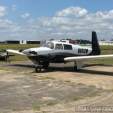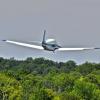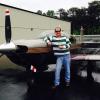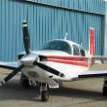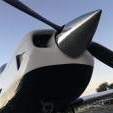Leaderboard
Popular Content
Showing content with the highest reputation on 05/16/2019 in all areas
-
True. But that requires building a relationship with the shop before handing over the plane. I took my 252 to three different avionics shops before settling on one. I also got opinions from my AI with whom I have a great relationship built over years and trust explicitly. It was pretty obvious that the shop I settled on thought the same way I did about the work that needed to be done. Obviously shit happens. But my Mooney doesn't go into any shop without a very clear understanding of the expectations, business practices, and agreements in writing about how it will all go down. I did have one situation where my plane was in the shop and the owner and I came to a disagreement over the way forward. I showed up at the shop, paid the bill to that point, and took possession of the plane. I reinstalled pieces that were disassembled, and flew the plane out. The shop owner told me the plane was not airworthy and couldn't be moved. I said I wasn't asking for his opinion and flew the plane away to another shop. That was a couple of years ago. It was a good lesson to learn. Keep control of the situation. Check in often. Show up and inspect the progress. And at the end of the day, I'm PIC and I'm the owner. I determine if I can fly the plane or not.6 points
-
OMG! I feel for you. But let me second what @LANCECASPER said. No one should ever go into any shop for an upgrade without knowing as much or more than the shop knows. In this day and age with everything available on the Internet, there is no reason not to know. And when spending $20 to $100 AMU's, it's worth the time to educate ones self. Back in 2014 I knew nothing about Mooneys much less what went in a Mooney panel. Today, I know as much or more about the options for Mooney panels than any avionics shop in the country. And everyone can have the same information for free. When I take my Mooney in for avionics upgrades, I call the shots and say what will be done. And when an avionics shop disagrees with me, I find another shop. After all, I know better than they do. It's the only way to operate in this business.6 points
-
G1000 ovations with STEC autopilots can be "reverse engineered" and have a GX3 with a G500 AP put in! The Ovations were "optional" to have the G1000. I imagine the same is true on the STEC Bravo's. Got your ears on @Deb5 points
-
It seems like a simple issue to just remove one of the G5s, reinstall the KI256 and realign the KC192 to get your KFC 150 back up and running. Then at a latter date have somone else install the GFC 500 that does work with the G5. With the G5 already installed, after you sell the KC 192 and its 3 servos, the cost should run around 15K net for the 4 servo model. Dealing with attorneys is a downer and just prolongs the pain of the mistake.5 points
-
This is what I meant. I'm paying an avionics shop to know how to run wires, solder joints and know what connectors to use, and to sign my log book. But I chose the components and their arrangement in the panel. @steingar is correct that there is a lot to know about a lot of boxes. But I'm just not confident there is any avionics shop out there that knows all that data either. They're too busy running wires and doing installs to read all the marketing material, user guides, etc. And the manufacturer reps are obviously biased. In fact I've found avionics shops to be biased towards what is easiest to install and what has the best margin for them. But since I'm the guy who's gonna spend all the hours with my nose just inches from this panel, I want it to be right and no one has more of a vested interest in that than me.5 points
-
I'm attaching what a really good bid looks like. As you can see, the parts cost should be about the same for all bids. The bid differences I found were in the labor costs. Estimate_1343_from_EE_Aviation_dba_Chandler_Avionics.pdf3 points
-
Don’t worry about weather Don. I say that because the kids are coming in this weekend for my birthday on Sunday. That means I won’t be able to make it. THAT in turn means that since I want to be there and can’t, the weather will straighten out and be fine. Isn't that some positive attitude logic?3 points
-
Greg I looked at the pictures, all the pins look like they are seated properly, the other thing I'm looking for is any of the contacts that don't spring back. I can't see any in the pictures, take a good look as well. Stabilant 22 is great for any connector, I use it on everything I touch. Bob Weber WebairConsulting.com2 points
-
Well, I personally think it's a great idea to practice on a crosswind runway when traffic permits. You never know when you might need that skill for real! Richard Collins used to say something to the effect that personal minimums may be useful for planning purposes, but once aloft, what you see is what you get, and you might just have to shoot an approach to minimums even if that's lower than your "personal" minimum, so you better stay sharp. Short fields, soft fields, crosswinds, slow flight, steep turns -- all that stuff we were good at one upon a time gets lost if we don't practice. Skip2 points
-
As I understand it, the G-1000 was optional on the M20R certification with the STEC installed, so it can be done. Is the exclusion on the Garmin certification only if the G-1000 is presently installed? Because you could take it out that "option" then there wouldn't be a G-1000 to worry about. You aren't adding a G3X or GFC500 to a G-1000...You are adding it to an M20R.2 points
-
I just went on to the STEC website and the 3100 is not certified for Mooney aircraft yet according to their website. It is apparently in the works but not yet certified. However, according to the website the cost to change from an STEC 30 to a 3100 will probably be far less than changing out to a GFC500.2 points
-
you do not have to know the ins and outs of how to install the equipment, just the knowledge of what works with what and what you want it to do. by talking to several shops and here on Mooneyspace you can set your expectations before dropping off the plane.2 points
-
Chris, this has been a long and interesting thread. From your description in your posts, here's what likely happened: Your airspeed was too high on short final and, perhaps due to the obstructions, you were maybe a bit high also. At some point, as you started using up runway, you forced the plane down to the ground before it was ready. That's the only way to get it to land on the nose wheel, and that's why it bounced. It's also very common, so don't feel bad. This didn't happen with your instructor because an instructor would have seen this coming and had you correct or go around. You only need to satisfy two conditions for a good landing: 1) The airplane needs to be aligned with the centerline, flying level and decelerating a few inches above the runway, and 2) the airplane needs to be in a nose high attitude. If you do that, it will land itself. There are numerous techniques to get the airplane to a point that satisfies those two conditions, and pilots will argue endlessly about which technique is best. Fly safe, Skip2 points
-
I don't think I'd allow a shop to touch my airplane if they installed a G5, and didn't even realize that the autopilot wasn't working. they should know that the G5 AI and KFC isn't compatible, but the fact that they were able to deliver the aircraft without knowing that the AP wasnt working would make me somewhat reluctant to have them as my avionics shop.2 points
-
Oh my goodness, any shop that didn't realize that the G5 isn't going to replace the KI-256 on a King Autopilot shouldn't be allowed to touch your airplane ever again. How exactly did they wire it thinking it would work? Nowhere in the install manual could they possibly find an application for the G5 to replace an attitude indicator in a King Autopilot. Are they a Garmin dealer? I'm guessing no. This is not something you want to hear, but you have to know exactly what you want before you ever let a shop start. You have to educate yourself on what is and what is not compatible with what you have in the airplane. I know . . that's supposed to be their job, but this would never have gotten to this point if you would have gone in their forearmed. That's what Mooneyspace is great for - post your thoughts and you will get responses. We all keep each other in check. Hopefully they didn't remove your vacuum system and backup. Please post the name of the shop so none of us go there. Regarding the bill - my thinking is that you owe them for the G5 HSI and labor. You don't say what your ADSB solution was, but you owe for parts and labor there. The only thing you don't owe for would be the time installing and removing the G5 Attitude Indicator and the G5 Attitude Indicator itself. However it sounds like you might have supplied your own G5's. Yes, the bill will be much more than it should have been and yes, you lost the use of your airplane for months - all of this is considered tuition for the education you received.2 points
-
OK, I’ll bite: why would rudder authority make for better landings? The only thing you need the rudder for is to keep it straight. Which reminds me: one of the not so great aspects of the Mooney design is that the nose wheel doesn’t disconnect from the rudder when fully extended as in many airplanes. And, since the steering is rigid (no bungees) you have to relax rudder pressure when the nose wheel comes down during a crosswind landing or you head for the grass. Bet that’s why the nose wheel deflection - and hence the turning radius - is limited. And, since the nose wheel pivots less than other airplanes, it’s more easily damaged by towing. Skip2 points
-
I didn’t have to show proof of purchase, but I believe I know why. I made the reservation and got the code. The avionics shop then did the installation and registered it with the the FAA. I believe that served as my proof of purchase.2 points
-
2 points
-
2 points
-
2 points
-
Probably the arm being further aft from the vertical axis confers additional yaw force and authority Sounds like the OP hasn’t mastered short / obstructed approaches. Not like that would be anything I’d be ready for home field or not with that level of experience in a new to me Mooney. Especially at a <3000 ft field. Would go out with an instructor and practice chopping power once clear of the obstacle , carrying about 5 MPH additional airspeed above your *calculated* weight-based approach speed and aim for prior to the line if your displaced threshold is unusable for landing. You should be able to touch down consistently just past the start of the runway bar. Personally if I couldn’t master that task over and over, I wouldn’t consider myself proficient for landing or departing on a runway of that length with obstructions. Close in obstructions are serious business especially when you start getting to the corners of the performance or aerodynamic envelope (search this site for Patrick or W78 crashes and you’ll get a sense of how wrong things can go so quickly at short or close in fields). My suggestion would be to do as your doing - work with the instructor. But you’re going to have to master landings on a less demanding runway before considering home base your home base. I say this from experience- I bald spotted a tire at N07 2700 ft in my first week of Mooney ownership. That airport has close in obstructions. I decided last week when up in that neighborhood - operating at max gross on a hot day with my family on board - that I wasn’t up to that task. Especially with regard to a planned departure after dark. I’m not current / proficient / recently familiar enough with that field to make it past my risk assessment. I have about 750 landings in my J - not inexperienced by any means but not to a point where I’d consider myself a master of all performance demands unless throughly practiced and proficient. I’ve also considered that flying with small children is some of the most demanding flying I’ve done. It’s riddled with potential for distraction or worse. If you can manage a four year old who wakes up in your copilot seat with a night terror on your base to final turn, or decides when she’s in the back seat she’s going to kick your seat like a brat when you’re flying an ILS... you can probably handle a G-V full of drunk and out of control Rock stars. At least a few of the Mooneyspacers have met my oldest daughter Olivia - who does long cross countries, ILSs, and flies formation with me. She’s an amazing kid but not always perfect so a plan A, B, and C is in order for every flight. Make sure you can bring your A-game and a half and have a child mitigation plan before doing anything but the lowest risk flying. But learn the how to bring the A game without the baby on board.2 points
-
Joe Cole is much of the reason I bought the Mooney I did. He is one heck of a stand up individual. Gave me a whole bunch of his time explaining things on the phone. I ever get back that way I just hope I have the chance to buy him a beer.2 points
-
One other thing to consider. I'm not sure which, but I was under the impression that some digital fuel gauges only have you set 4 or 5 fuel points during calibration. Is that the case for the EDM900? For my AeroSpace Logic FL202, calibration occurs in 2 gallon increments which is 17 data points for each wing of my M20J. Fuel level (float level) may not be linearly related to fuel on board. That is, a one inch drop in float level might correspond to 7 gallons when the tank is full but 5 gallons when nearly empty. If the gauge assumes a linear relationship between calibration points, that could result in some inaccuracy. How much I don't know. The more data points used during calibration, the less significant the error will be. Just thinking out loud (or more accurately with my fingers).2 points
-
Ok, I'll share my 'they all fly the same way' history. I've got at least 300 hours in each of these aircraft: M20J, T37, T38, F106, F15, DC9, 757 and 767. I landed them all the same way. Fly final on speed, gradual flare, hold it off until I reach the proper landing attitude. The only difference was what speed to fly on final (62 - 202 KIAS), when to start the flare, and when to pull the power (between 50' in the air and descent rate stopped). Although, to be honest, on the DC9-30 and larger, I got smoother landings if I was just inches above the ground and started to lower the nose just as the mains were touching down. They all land just fine when they are ready.2 points
-
If you spend 20-30 minutes on the phone with this guy he will walk you through your KFC150 problems without throwing parts at it. He is the King AP whisperer. Bob WeberWebAir Consulting616 822 19992 points
-
The KFC 150 WAS a good autopilot. It served me well for 26 years. I did have to have the pitch servo overhauled twice and the pitch trim servo twice during that time. While it has some digital electronics in it, it is still basically an analog autopilot. When the full scale resolution of the WAAS GPSs went down to 2 NM full scale in the enroute mode, the damping, at least on mine, was such that I got wing rock that I never was able to eliminate. Many times trying to match products from different manufactures, who want to blame each other for interface issues, doesn't work. I never was able to find anyone who knew the KFC 150 well enough to solve the issue between my Garmin stuff and the KFC 150. That will only get worse with regards the KFC 150, as the older techs who knew it well retire. With reasonably priced new all digital autopilots with modern light weight "smart" servos with brushless DC motors for greater reliability, in the long run, financially you'd be better off getting the new modern autopilot with envelope protection and the LVL button. I'm still happy to be staying with one manufacturer, who maintains interface compatibility. I'm really looking forward the my new GFC 500 as much to see if the wing rock is eliminated, as for all the other autopilot upgrades it provides.1 point
-
Or go a slightly different route and ditch the HSI and vacuum system and get an Aspen PFD with an EA 100 which of course works with the KFC 150. The KFC is a beautiful autopilot when working correctly, which to its credit it did for 20 years in my plane until it needed repair. Now that I have had mine overhauled I don’t think I’d be in rush to get rid of it.1 point
-
1 point
-
I have not found the perfect avionics shop, but I have several I trust enough to work on my plane. My problems have been with shops overestimating their production capacity (3 weeks turns into 2 months) but everything works when it comes out, and we all agreed up front what would be done and what the cost would be. Even when there is the "how much to add X" in the middle of the install, my on-field shop will give a written quote before proceeding and will update me on a regular basis as to progress and problems. I agree with @gsxrpilot about having to know what you want and how/if it can work together before going into the shop with a checkbook. Between MS and Google, while you may not know everything about every piece of avionics gear out there, you can do some in-depth research on what you are looking at for your own panel. As a sidebar, I want to thank @M20Doc, @Marauder, @gsxrpilot, and all the other folks on MS who share their wisdom on this site on a regular basis - too many to name individually. The knowledge available on this forum has helped me make some good decisions and avoid a couple of really bad and expensive ones.1 point
-
Wow. Now I feel much, much better about my own avionics shop from hell. At least everything the guy put in works, even if the boxes don't talk to each other that well. All due respect to Paul, but there are a lot of boxes out there and a lot to know. I already have a job that requires a lot of knowledge. I really don't feel like becoming an avionics tech. The reason I hire a someone else to do this is he doesn't get paid as much as I do. Moreover, the guy has oodles of specialized knowledge that I lack. That's why we hire these things out. Sounds like its getting harder and harder to find a good shop though.1 point
-
1 point
-
If they are a Garmin dealer, Garmin needs to know of the wrong advice given to you. I expect that Garmin will insure that the matter is corrected to your and their satisfaction. John Breda1 point
-
It's not quite that bad. The geometry of the nose gear provides a significant amount of positive caster. Caster is what keeps your car - or shopping cart - going straight. So, if you hold the rudder when the nose wheel touches, you will get an initial swerve, but - unless you continue to hold the rudder - it will self correct and the swerve will end. All you have to do is steer it back to the centerline.1 point
-
There are a lot of good MSC's around the country, but no one knows more about Mooneys than the Oracle in Longview, TX. And I mean nobody. I use JD and Laura at SWTA for all my maintenance and they are excellent! But when they get stumped, they pick up the phone, dial Longview, Texas and ask for Don.1 point
-
According to my old PA28 service manual, you are correct regarding early Cherokees. Beginning in 1974, bungees were added to the steering system. The nose wheel fairing aerodynamically centers the nose wheel in flight. There's a service bulletin #291 that details the addition of springs if the fairing is removed. I'm not sure how the retractable Cherokees work w.r.t. nose wheel centering. Usually, some sort of mechanism is required on a retractable to keep the nose wheel from getting cocked during retraction.1 point
-
1 point
-
1 point
-
I would do two things: 1) Tell Garmin that this dealer needs more training 2) Negotiate a smoking hot deal on a G500Txi with a GAD43e to interface to you kFC500. Especially if your vacuum system has been removed. Aerodon1 point
-
I have a somewhat similar story but not to the degree. A couple months back, I installed an engine monitor and once it was installed, there were some minor issues with it so i planned to get it fixed. in between picking up the plane on the finishing date, and going back to the shop to fix the minor issues, 52Q had to have his annual done. During this annual we found out that the EDM900 hadn't been installed exactly to the spec the manual stated and it needed a decent chunk of work to fix it. all in, we spent about 1500 bucks fixing all the issues with the EDM. some issues such as, NO AMP READING, Probes not crimped properly, fuel tanks not even close to properly calibrated, fuel flow transducer was leaking fuel during the flights, and mounted completely wrong, and a couple other issues. Overall I'm glad Foothill fixed all the issues with the EDM. I didn't bother following up with the original shop that installed it because I didn't really want them touching anything on the plane. If i were you, I would definitely not let them touch the airplane anymore. They've made it very clear that they don't know what they're doing. my guess is that if you had 2 G5's installed and a gtx345, that ramped up a nice bill somewhere around 15 to 20k. figure out a deal with the shop and keep them away from your aircraft. I would definitely be expecting a discounted price at least.1 point
-
@PT20J I was thinking about rudder authority for a short/med body F versus a long body. Given a similar CG location, the longer arm from the yaw axis to the control surface would confer greater authority in the long body, correct? Edit - I see your first post - were on the same page for this one.1 point
-
1 point
-
I have one in Lakeland where T-hangars go for ~$320/month. They have built some new ones and are improving taxiways around the GA hangar area. Bartow had some hangars available, and currently has a wait list for them. Looking at about the same price there.1 point
-
I've landed my R at Gaston's several times. Use proper technique and you're good. I do appreciate having speed brakes on landing, though. Do a normal short-field landing with them stowed, but as soon as you're level just above the ground, pop them out - That helps to get your wheels down and into the grass, and also helps to keep you from getting thrown back into the air by some of the bumps.1 point
-
Nice! So what altitude(s) did you fly? I'd be looking at a break halfway in any case, to stretch our legs, hit the restroom, etc..1 point
-
Yep, still lots of the same old same old Carusoam still hogging all the bandwidth, Marauder still delighting us with pics of his girlfriends....1 point
-
In my defense, I am old. You can't expect me to remember something I read more than 2 minutes ago!1 point
-
Thanks John, This year, @Seth is at the helm and promises to have a fabulous Mooney Summit VII. I am sure he will be emailing everyone shortly where we are with everything. Everyone is working towards getting a larger venue In PCB to accommodate more people, as we have a huge wait list again. @Hank is soliciting raffle and silent auction donations to help fund our charity. Unlike COPA, we are not owned by Mooney and have to grovel for funding, and one of the reasons we have been successful is we do not charge for the event, but ask everyone to donate what they feel the value is. Some have really impressed us with their valuation, while just a few have taken advantage of the generous ones. Moving the venue would not be voted for by @rocketman, as he donates 17 condos for use by SME's and those of his choosing, along with his 2 beach houses. FIgure in the rent for these and we would have an additional 10K in costs. I wonder how the Cirrus's will handle avoiding landing in Lake Ponchatrain for their convention?1 point
-
I use blue Wash Wax all for the plane and Red for the belly. Works great, and no need to wax when finished.1 point
-
I don't own a Bravo but got my IFR in my M20K a couple years ago. I don't use a "power setting" but I do whatever it takes to remain a stable glide path at 90kts (too) until runway enviornment - good advise.1 point
-
Where are you located? I am in the Seattle area, am a retired Boeing antenna engineer, and have a piece of test equipment called a network analyzer that can be used to determine the health of cables, power splitters, diplexers and antennas. I would be happy to make the measurements if you were in the local area. My Mooney is currently in for it’s annual inspection so I am essentially grounded for another week or two.1 point



